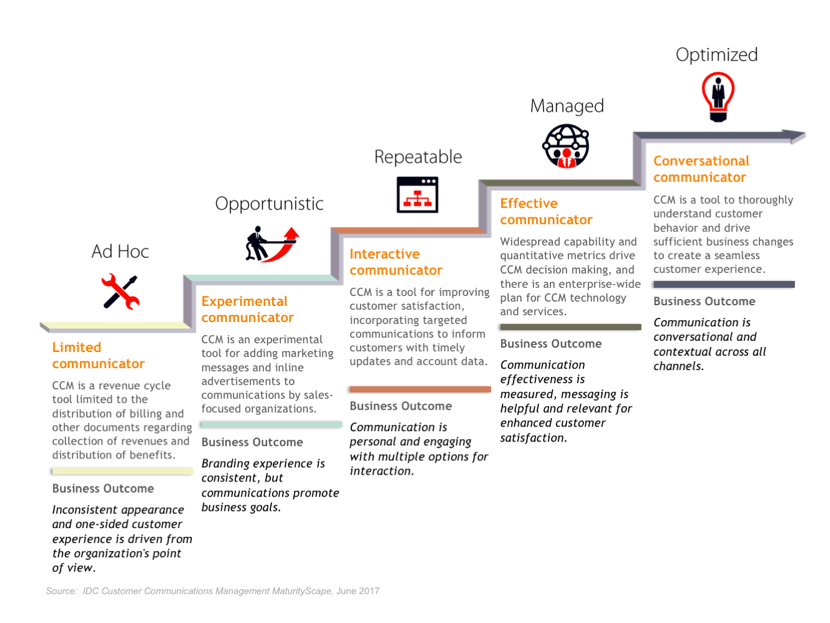
Image by: Mykyta Dolmatov, ©2019 Getty Images
Managing customer communications is a significant driver for improving customer satisfaction and increasing lifetime customer value in an organization. Yet, it remains under the radar within many businesses, despite its increasing importance in driving digital transformation within the enterprise.
Customer communications management (CCM) solutions are entering a fourth stage of evolution, where early-stage technology, like machine learning or intelligent processing, is being leveraged to further automate and advance business-critical (i.e., revenue-driven), interactive (or service-oriented), and marketing communications. This evolution will expand the interest of CCM within the enterprise and raise the level of integration required across business functions and information technology (IT) systems.
Worldwide companies spend more than one billion dollars each year on CCM solutions and services. Therefore, knowing which stage of communications maturity you are at today will help you utilize your investment in CCM more effectively and prepare you to augment it with artificial intelligence (AI) and innovation accelerators.
The first step for effectively managing communications across the customer journey is to adopt consistent practices around CCM investments and to optimize processes based on organizational priorities. This is best accomplished by considering the five dimensions of CCM, which contribute to the larger strategy of digital transformation: vision, people, process, technology, and customer experience initiatives.
The first step for effectively managing communications across the customer journey is to adopt consistent practices around CCM investments and to optimize processes based on organizational priorities. This is best accomplished by considering the five dimensions of CCM, which contribute to the larger strategy of digital transformation: vision, people, process, technology, and customer experience initiatives.
IDC research shows that the marketing department is often responsible for the CCM budget and initiatives, but marketing may lack the necessary operational view required to fully understand the complex interactions in which CCM platforms are evolving to support.
A Look at the IDC MaturityScape for Customer Communications Management
This holistic view of customer communications—and the supporting processes that are required to achieve it—is the focus of IDC's Customer Communications Management MaturityScape. It is intended to help key stakeholders of CCM initiatives to evaluate their current CCM capabilities within their organizations and identify the next significant steps to align these CCM initiatives with the strategic goals of the broader enterprise.Our maturity model for managing customer communications describes the organizational characteristics at five levels, from ad hoc, limited exposure to one in which understanding customer behavior will be augmented with artificial intelligence (AI) solutions.

IDC's Customer Communications Management MaturityScape outlines the 5 stages of organizational capabilities to deliver seamless experiences and encourage further customer engagement.
- Ad Hoc: The customer experience is very poor and one-sided. It is driven purely from the organization's point of view. Ad hoc correspondence is not standardized, branding is inconsistent, and electronic communications are sporadic and unreliable. Customers are often forced to call or email the company to get additional information.
- Opportunistic: The business has increased visibility into CCM activities, but it remains functionally siloed to marketing efforts. The customer has a more consistent experience with branding but receives communications that primarily promote business goals. Customers can typically get additional information via at least one online channel, but customer inquiry response is labor-intensive and response times are often long.
- Repeatable: At this stage, leadership understands the cost and complexities of effective outbound communications for engaging customer experiences. Access points have been standardized between channels, and customers have multiple options for making inquiries. Workflow automation improves customer response time, and integration between CCM and customer relationship management (CRM) platforms ensure better accuracy.
- Managed: Customers have a consistent experience across all channels, with functionality and interactivity optimized to each channel's capabilities. Real-time data feeds and analytics of customer activity are incorporated into the customer experience to provide immediacy and recommended options based on strategic objectives. Automated CCM workflow encompasses content approval and extends to mobile devices.
- Optimized: Customer experience is conversational, with rapid response to issues, timely updates, and interactive engagement. Customers can seamlessly switch between channels while maintaining conversational context, as all previous information is available across the organization.
Today, organizations are focused on optimizing processes and improving customer engagement. As CCM continues to be influenced by innovative technologies, it is vital for organizations to evaluate the role that digital communications can have on business transformation and the ultimate future of work. This maturity model provides a framework for that evaluation.
Marci Maddox is the Research Manager for IDC's Enterprise Content Strategies program and is responsible for content workflow and content technologies research. She has 15 years of experience working with content and process applications at companies like OpenText and IBM and has helped clients realize the future of AI, IoT, and cloud benefits. Follow her on Twitter at @idcmarci or visit www.idc.com.














